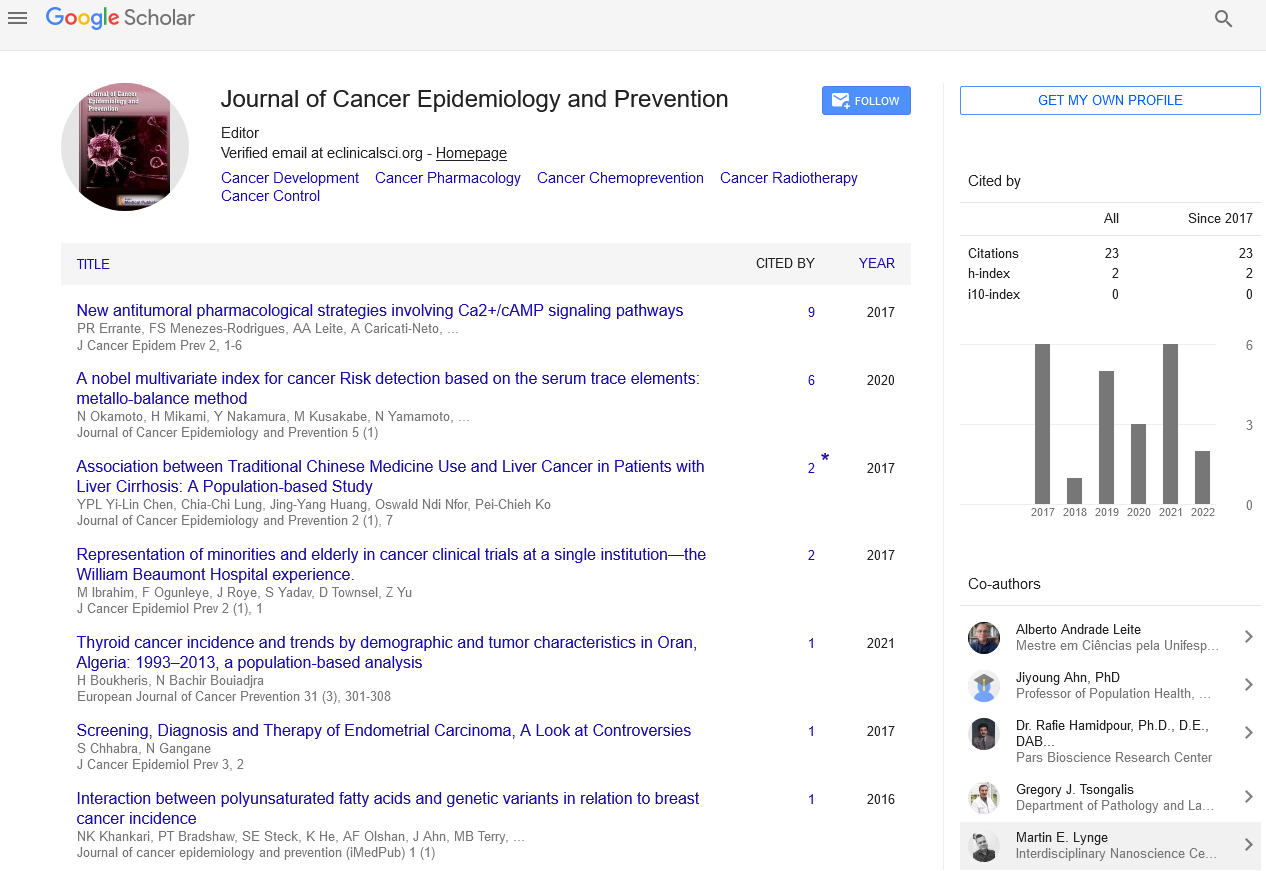Abidugun Azi*
Department of Medical Science, Elizade University, Ondo, Nigeria
- *Corresponding Author:
- Abidugun Azi
Department of Medical Science
Elizade University
Ondo, Nigeria
E-mail: aziabi@gun.in.com
Received Date: October 05, 2021; Accepted Date: October 18, 2021; Published Date: October 25, 2021
Citation: Azi A (2021) A Brief Note on Colon Cancer. J Cancer Epidemiol Prev. Vol.6 No.5:5
Description
Colon cancer is due to old age and life factors, with only a
small number of cases due to underpinning inheritable diseases.
Threat factors include diet, rotundity, smoking, and lack of
physical exertion. Salutary factors that increase the threat
include red meat, reused meat, and alcohol. Another threat
factor is seditious bowel complaint, which includes Crohn's
complaint and ulcerative colitis. Some of the inherited
inheritable diseases that can beget colorectal cancer include
domestic adenomatous polyposis and heritable on-polyposis
colon cancer; still, these represent lower than 5 of cases. It
generally starts as a benign tumor, frequently in the form of a
neoplasm, which over time becomes cancerous. Bowel cancer
may be diagnosed by carrying a sample of the colon during a
sigmoidoscopy or colonoscopy. This is also followed by medical
imaging to determine whether the complaint has spread.
Webbing is effective for precluding and dwindling deaths from
colorectal cancer. Webbing, by one of a number of styles, is
recommended starting from the age of 50 to 75. During
colonoscopy, small cysts may be removed .However; a
vivisection may be performed to check if it's cancerous, if a large
neoplasm or tumors is plant. Aspirin and other on-steroidalantiinflammatory
medicines drop the threat. Their general use isn't
recommended for this purpose, still, due to sideeffects.The signs
and symptoms of colorectal cancer depend on the position of
the tumor in the bowel, and whether it has spread away in the
body (metastasis). The classic warning signs include worsening constipation, blood in the coprolite, drop in coprolite class
(consistence), loss of appetite, loss of weight, and nausea or
puking in someone over 50 times old. Around 50 of
individualities with colorectal cancer don't report any symptoms.
Rectal bleeding or anemia is the high- threat symptoms in
people over the age of 50. Weight loss and changes in a person's
bowel habit are generally only concerning if they're associated
with rectal bleeding. 75 – 95 of colorectal cancer cases do in
people with little or no inheritable threat. Threat factors include
aged age, manly coitus, high input of fat, sugar, alcohol, red
meat, reused flesh, rotundity, smoking, and a lack of physical
exercise. Roughly 10 of cases are linked to inadequate exertion.
The threat from alcohol appears to increase at lesser than one
drink per day. Drinking 5 spectacles of water a day is linked to a
drop in the threat of colorectal cancer and adenomatous cysts.
Streptococcus gallolyticus is associated with colorectal cancer.
Some strains of Streptococcus bovis/ Streptococcus steed’s
complex are consumed by millions of people diurnal and
therefore may be safe. 25 to 80 of people with Streptococcus
bodies/ gallolyticus bacteremia have attendant colorectal
tumors. Seroprevalence of Streptococcus bodies/ gallolyticus is
considered as a seeker practical marker for the early vaticinator
of an underpinning bowel lesion at high threat population. It has
been suggested that the presence of antibodies to
Streptococcus bovis/ gallolyticus antigens or the antigens
themselves in the bloodstream may act as labels for the
carcinogenesis in the colon.

